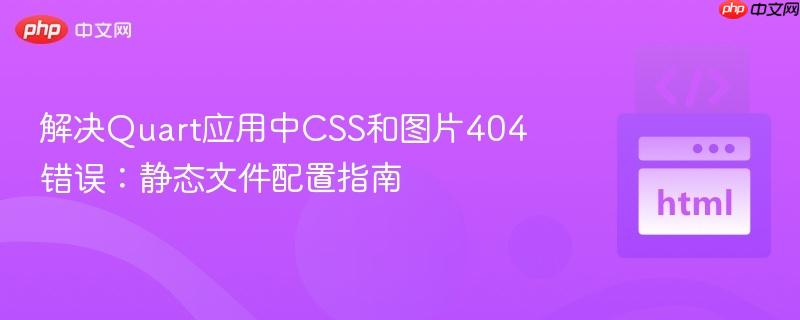
本文旨在解决quart web应用中常见的静态文件(如css、javascript和图片)无法正确加载导致的404错误。核心在于理解quart(及类似flask的框架)对静态资源的约定:将它们放置在专门的`static`目录下,并通过`url_for('static', filename='...')`函数在html模板中动态引用,确保服务器能正确识别并提供这些资源,从而实现页面的完整渲染。
在开发Web应用程序时,除了动态生成的HTML内容,我们还需要引入CSS样式、JavaScript脚本和图片等静态资源。这些资源与模板文件(HTML)的处理方式有所不同。Quart框架,作为Flask的异步版本,遵循了类似的约定来管理这些静态文件。当静态文件无法加载时,通常会在浏览器控制台中看到404(Not Found)错误,这表明服务器未能找到或正确提供这些资源。
原始问题中,用户将style.css和some_image.png文件放置在templates/index/目录下,并在index.html中直接使用相对路径index/style.css和index/some_image.png进行引用。这种做法在多数Web框架中是行不通的。
Web服务器(包括Quart内置的开发服务器)默认情况下会区分“模板文件”和“静态文件”。
Quart框架默认期望静态文件位于应用程序根目录下的一个名为static的文件夹中。当你在HTML模板中直接使用相对路径引用位于templates目录下的文件时,Quart服务器并不知道如何将这些文件作为静态资源来服务,从而导致404错误。
立即学习“前端免费学习笔记(深入)”;
要解决静态文件无法加载的问题,首先需要调整项目的文件结构。将所有静态资源(CSS、JS、图片等)统一放置在应用程序根目录下的static文件夹中。
app/
static/
style.css
some_image.png
templates/
index.html
main.py在这个结构中:
文件结构调整后,下一步是在HTML模板中正确地引用这些静态资源。Quart提供了一个非常有用的函数url_for(),它可以根据给定端点和参数动态生成URL。对于静态文件,url_for()的第一个参数应为'static',第二个参数filename则指定static目录下的文件路径。
例如,要引用static/style.css,应使用url_for('static', filename='style.css')。 要引用static/some_image.png,应使用url_for('static', filename='some_image.png')。
更新后的 index.html 示例:
<!doctype html>
<html lang="en">
<head>
<!-- 使用 url_for 引用 style.css -->
<link rel="stylesheet" href="{{ url_for('static', filename='style.css') }}">
<meta charset="UTF-8">
<meta name="viewport"
content="width=device-width, user-scalable=no, initial-scale=1.0, maximum-scale=1.0, minimum-scale=1.0">
<meta http-equiv="X-UA-Compatible" content="ie=edge">
<title>Some title</title>
</head>
<body>
<div class="container">
<!-- 使用 url_for 引用 some_image.png -->
<img src="{{ url_for('static', filename='some_image.png') }}" alt="something" style="width:50%;">
<a href="/login">
<button class="button button_Login">Login</button>
</a>
</div>
</body>
</html>main.py 保持不变,它负责渲染 index.html:
from quart import Quart, render_template, redirect, url_for
app = Quart(__name__)
@app.route("/")
async def index():
return await render_template("index.html")
# 注意:Quart在debug模式下会自动服务static目录下的文件。
# 在生产环境中,通常会使用Nginx或Apache等Web服务器来服务静态文件。
if __name__ == "__main__":
app.run(debug=True)style.css 内容示例(放置在 static/ 目录下):
.container {
position: relative;
text-align: center;
}
.container .button_Login {
position: absolute;
bottom: 1%;
left: 50%;
transform: translate(-50%, -50%);
background-color: black;
border: 3px solid #eeccff;
color: white;
padding: 15px 32px;
text-align: center;
border-radius: 4px;
font-size: 20px;
transition-duration: 0.4s
}
.container .button_Login:hover {
color: black;
background-color: #eeccff;
}
.button_Login:active {
position: relative;
top: 2px;
}
body {
background: black;
}通过上述修改,当Quart应用程序运行时,它将能够正确地识别并提供static目录下的style.css和some_image.png文件,从而使页面样式和图片正常显示。
正确地管理和引用静态文件是构建健壮Web应用程序的关键一环。在Quart框架中,遵循将静态资源放置在专门的static目录下,并使用url_for('static', filename='...')在模板中引用的约定,能够有效解决静态文件加载失败的404错误,确保Web页面的样式、交互和媒体内容能够完整、正确地呈现。理解这一机制对于Quart应用的开发至关重要。
以上就是解决Quart应用中CSS和图片404错误:静态文件配置指南的详细内容,更多请关注php中文网其它相关文章!

每个人都需要一台速度更快、更稳定的 PC。随着时间的推移,垃圾文件、旧注册表数据和不必要的后台进程会占用资源并降低性能。幸运的是,许多工具可以让 Windows 保持平稳运行。

Copyright 2014-2025 https://www.php.cn/ All Rights Reserved | php.cn | 湘ICP备2023035733号